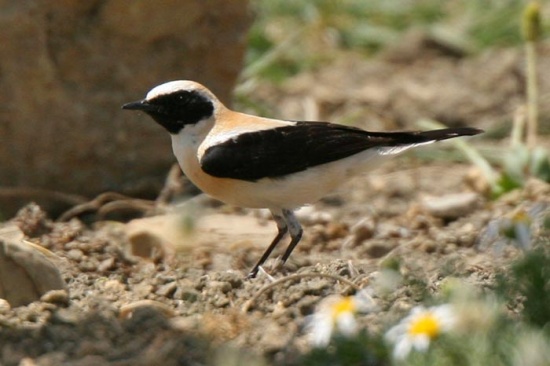m |
(gs) |
||
| (29 intermediate revisions by 9 users not shown) | |||
| Line 1: | Line 1: | ||
| − | + | [[Image:2011Black-eared-Wheatear-09-702.jpg|thumb|550px|right|Male <br />Photo © by {{user|sdaly|sdaly}}<br />[[Andalucia]], Southern [[Spain]]]] | |
| − | [[Image: | + | ;[[:Category:Oenanthe|Oenanthe]] hispanica |
| − | |||
| − | |||
| − | |||
| − | '' | + | ==Identification== |
| + | |||
| + | 13.5-15.5 cm (5¼-6 in).<br /> | ||
| + | '''Male''' - white forehead and crown, buff mantle, black wings, underparts are white tinged with buff, white back, upper tail coverts and tail, black ear coverts, black line from the bill, sometimes black throat. | ||
| + | |||
| + | In autumn and winter the head and mantle are distinctly buff, as are the underparts, including the throat, but the buff varies in intensity. | ||
| + | |||
| + | '''Female''' - browner bird, and her seasonal changes are less marked. Can show a dark chin and face in autumn. | ||
| + | ====Variations==== | ||
| + | Males come in two colour morphs - pale throated and black throated, with pale throated the commoner. | ||
| + | ====Similar species==== | ||
| + | Males of [[Eastern Black-eared Wheatear]] (as seen in [[Cyprus]], for example) are much paler above than the western form. They can look almost black and white in strong sunlight, with just a pale sandy brown colouration. | ||
| + | |||
| + | Identification of younger birds of this species versus [[Pied Wheatear]] is discussed in a [[http://www.birdforum.net/showthread.php?t=101414 thread]] in the Identification forum. | ||
| + | ==Distribution== | ||
| + | This species is found from south-western [[Europe]] and northern [[Africa]] to [[Senegal]] and [[Mali]].<br /> | ||
| + | ==Taxonomy== | ||
| + | This is a [[Dictionary_M-S#M|monotypic]] species<sup>[[#References|[1]]]</sup>. | ||
| + | |||
| + | Previously joined with [[Eastern Black-eared Wheatear]] under the name of Black-eared Wheatear. | ||
| + | [[Image:Black-eared Wheatear 10.jpg|thumb|350px|right|Photo © by {{user|Bert|Bert}}<br />Alentejo, [[Portugal]], September 2017]] | ||
| + | ==Habitat== | ||
| + | Stony mountainous slopes, usually below 600 m; open countryside, maybe with a few trees. | ||
| + | ==Behaviour== | ||
| + | ====Diet==== | ||
| + | The diet includes insects. | ||
| + | ====Breeding==== | ||
| + | Nests in holes among rocks and walls, or under tussocks of grass. | ||
| + | |||
| + | ==References== | ||
| + | #{{Ref-Clements6thAug21}}#Collins Field Guide 5th Edition | ||
| + | #{{Ref-Grantetal99}} | ||
| + | {{ref}} | ||
==External Links== | ==External Links== | ||
| − | + | <!--- Comment to editors: Using the scientific name for GSearch makes no sense in this case. It will find the correct ones and a lot of images we are not sure of whether they are western or eastern, including those uploaded by those who does not have new field guides when they really should be using Oenanthe melanoleuca instead. | |
| − | [[Category:Birds]] | + | Search the Gallery using the scientific name: |
| + | {{GSearch|Oenanthe+hispanica}} | ||
| + | ---> | ||
| + | |||
| + | {{GSearch|"Western Black-eared Wheatear"}} | ||
| + | {{GS-checked}} | ||
| + | [[Category:Birds]] [[Category:Oenanthe]] | ||
Latest revision as of 23:19, 4 October 2022
- Oenanthe hispanica
Identification
13.5-15.5 cm (5¼-6 in).
Male - white forehead and crown, buff mantle, black wings, underparts are white tinged with buff, white back, upper tail coverts and tail, black ear coverts, black line from the bill, sometimes black throat.
In autumn and winter the head and mantle are distinctly buff, as are the underparts, including the throat, but the buff varies in intensity.
Female - browner bird, and her seasonal changes are less marked. Can show a dark chin and face in autumn.
Variations
Males come in two colour morphs - pale throated and black throated, with pale throated the commoner.
Similar species
Males of Eastern Black-eared Wheatear (as seen in Cyprus, for example) are much paler above than the western form. They can look almost black and white in strong sunlight, with just a pale sandy brown colouration.
Identification of younger birds of this species versus Pied Wheatear is discussed in a [thread] in the Identification forum.
Distribution
This species is found from south-western Europe and northern Africa to Senegal and Mali.
Taxonomy
This is a monotypic species[1].
Previously joined with Eastern Black-eared Wheatear under the name of Black-eared Wheatear.
Habitat
Stony mountainous slopes, usually below 600 m; open countryside, maybe with a few trees.
Behaviour
Diet
The diet includes insects.
Breeding
Nests in holes among rocks and walls, or under tussocks of grass.
References
- Clements, J. F., T. S. Schulenberg, M. J. Iliff, S. M. Billerman, T. A. Fredericks, J. A. Gerbracht, D. Lepage, B. L. Sullivan, and C. L. Wood. 2021. The eBird/Clements checklist of Birds of the World: v2021. Downloaded from https://www.birds.cornell.edu/clementschecklist/download/
- Collins Field Guide 5th Edition
- Grant, P.J., K. Mullarney, L. Svensson, D. Zetterstrom (1999) Collins Bird Guide: The Most Complete Field Guide to the Birds of Britain and Europe. Harpercollins Pub Ltd ISBN 0 00 219728 6
Recommended Citation
- BirdForum Opus contributors. (2024) Western Black-eared Wheatear. In: BirdForum, the forum for wild birds and birding. Retrieved 2 May 2024 from https://www.birdforum.net/opus/Western_Black-eared_Wheatear
External Links
GSearch checked for 2020 platform.





